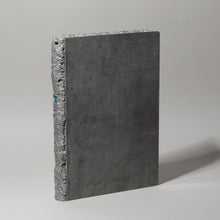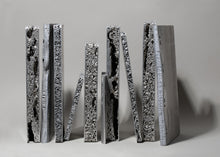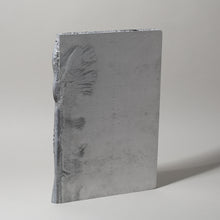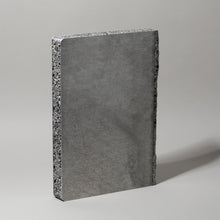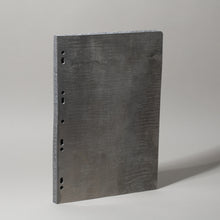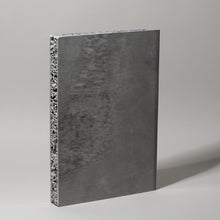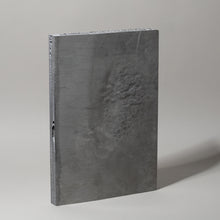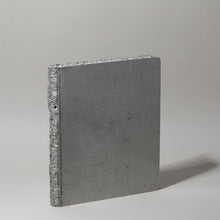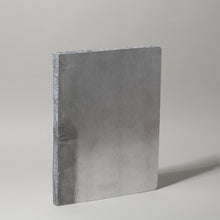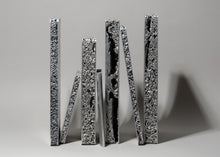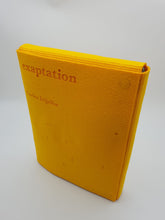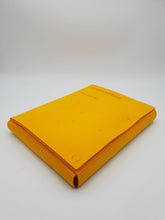
Carlos Irijalba
Libro de artista
24 piezas de metal foam en estuche de fieltro grabado y numerado
(2019)
Gastos de envío gratuitos dentro de España
Exaptation es el primer libro de artista de Carlos Irijalba. Veinticuatro piezas escultóricas únicas —mismo número que costillas humanas— elaboradas con un material emparentado en lo estructural con el hueso de los vertebrados, el metal foam o espuma metálica, y que el artista ha utilizado en Muscle memory (2016-2018), una reflexión formal en torno a dicho material y al modo en que la industria lo ha asimilado, un proceso equiparable a la deglución, digestión y secreción de cualquier organismo vivo.
Irijalba toma prestado el término exaptación de la paleontología, disciplina que lo emplea para definir la adecuación de una mutacion para un fin diferente a aquel para el que se desarrolló. Los huesos de los vertebrados suponen uno de sus ejemplos más claros. En un primer momento, solo eran almacenes de calcio que pasaron a proteger los órganos internos y, tras millones de años de evolución, con el salto a la vida terrestre, a ser estructura y soporte de numerosos organismos.
El metal foam constituye un caso contemporáneo de exaptación. Concebido originariamente para el desarrollo de prótesis por su semejanza con el hueso, ha pasado a ser utilizado por las industrias de la automoción y aeroespacial, que lo han adaptado a su propio uso. Un material que permite al artista reflexionar sobre los procesos cognitivos y la materialización de su propósito.
Las piezas que conforman el proyecto tienen el aspecto de libro tradicional (tienen lomo, cubiertas y tripa), pero son en realidad una cavernosa caja torácica que aloja la esencia de lo humano, su capacidad para desarrollar sustancias y soluciones antes impensables, y que es a su vez contenedor de tantas otras posibles aplicaciones latentes. Una suerte de repositorio mineral que, al igual que las costillas y que el metal foam, puede adquirir nuevos propósitos: ¿cuáles serán los nuevos recipientes del conocimiento acumulado en las páginas de este libro imposible? ¿Qué nuevos soportes, qué formas de transmisión y circulación de las ideas nos permitirá la reordenación del mundo ya existente? ¿A través de qué nuevas materialidades se protegerá la esencia del conocimiento futuro?
Carlos Irijalba ha mostrado en su trayectoria una clara inclinación por explorar las posibilidades formales de procesos geológicos o biológicos, por incorporar lo científico a su obra, en un continuo juego dialéctico entre obsolescencia y exaptación. «Me interesa la dicotomía entre exaptación y su posible antónimo —explica el artista—. Profundizar en que no todo curso evolutivo es lineal, es decir, el vector evolutivo no es uno y único. De algún modo la evolución es el resultado del cruce entre línea del tiempo y adaptación. No hay una única forma de evolución como el darwinismo simplificado sugiere, sino una larga cadena de prueba y error, consciente e inconsciente, determinación y azar, endógeno y exógeno, adaptación y exaptación».
Carlos Irijalba (Pamplona, 1979) vive entre Nueva York y Ámsterdam. Graduado por la Universidad del País Vasco y la UDK de Berlín, ha sido galardonado con la beca Guggenheim Bilbao de fotografía 2003 y la beca de Artes Plásticas Marcelino Botín 2007/08 o el premio Purificación García 2009 y Generaciones 2009, entre otros. Ha expuesto recientemente en centros internacionales como el CAB del Bruselas, MUMA Melbourne o LMCC Nueva York. Su trabajo está impulsado por el principio de pertinencia, el carácter necesario o superfluo de un objeto para convivir en el mundo existente. La relación potencial de un objeto, imagen o instalación para activar los lugares donde habitan y reaccionar entre la experiencia relativa de tiempo y territorio o la construcción colectiva de lo real.
Artist’s Book
24 pieces of metal foam in felt sleeves, individually engraved and numbered
Exaptation is the first artist’s book by Carlos Irijalba. It consists of twenty-four unique sculptural pieces – the same as the number of ribs in the human body – made from a material that is closely related, in terms of its structure, to the bones of vertebrates: that is, metal foam. The artist used this in Muscle memory (2016-2018), a formal reflection on said material, and on how the industry has taken it in, a process not unlike the swallowing, digestion and secretion of any living organism.
Irijalba borrows the term exaptation from palaeontology, a discipline where it is used to define how a given mutation adapts to take on a purpose that is different to the one it was originally developed for. The bones of vertebrates are one of the clearest examples of this. At first, bones were there just for storing calcium, but then they went on to protect the internal organs, and, following millions of years of evolution, along with the leap to land-dwelling, they became the structure and supporting frame for numerous organisms.
Metal foam is a contemporary case of exaptation. It was originally conceived for the development of prosthetic limbs, due to its similarity to bone, and it has gone on to be used by the automotive and aerospace industries who, in turn, have adapted it for their own purposes. It is a material that allows the artist to reflect on the cognitive processes and materialisation of his own artistic vision.
The pieces that make up this project look like a traditional book (they have a spine, covers and insides), but each one is in fact a cavernous, thoracic box which houses the human essence, the ability to develop previously unthinkable substances and solutions, and which is, at the same time, a container for so many other possible applications that are yet to be realised. A kind of mineral repository that might, as with ribs and metal foam, acquire new functions: who will be the new recipients of the knowledge accumulated in the pages of this impossible book? What new devices, what formats for the transmission and circulation of ideas will allow for a reordering of the world as we know it? What kind of new materialities will be used to protect the essence of future knowledge?
Carlos Irijalba has shown, in his career to date, a passion for exploring the formal possibilities of geological or biological processes, for incorporating scientific knowledge into his work, in an ongoing dialectical game between obsolescence and exaptation. “I am interested in the dichotomy between exaptation and its possible opposite”, explains the artist. “I want to investigate, in depth, the fact that not all evolutionary paths are straight lines, that evolution can take more than just one course. To some extent, evolution is the result of the crossover between the timeline and adaptation. There is not one sole form of evolution, as simplified Darwinism suggests, but rather there is a long chain of trial and error, conscious and subconscious, choice and chance, the endogenous and the exogenous, adaptation and exaptation”.
Carlos Irijalba (Pamplona, 1979) lives between New York and Amsterdam. He is a graduate of both the University of the Basque Country and the UdK, Berlin. He has won numerous awards, including the Guggenheim Bilbao 2003 photography prize, the Marcelino Botín 2007/08 Fine Arts grant, the Purificación García prize 2009 and Generaciones 2009, among others. Recently, he has exhibited in international spaces such as the CAB in Brussels, the MUMA, Melbourne, and the LMCC, New York. His work is driven by the principle of pertinence, the necessary or superfluous character of an object so it can assume its place in the existing world. The potential relation of an object, image or installation to activate the places they inhabit, and to react amid the relative experience of time and territory or the collective construction of the real.












